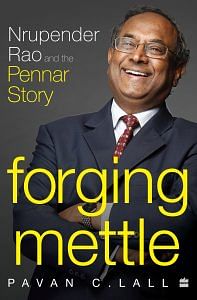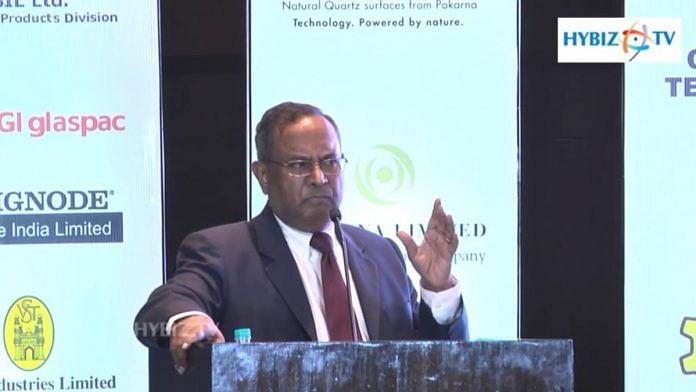In 1965, India and Pakistan went to war. Rao and his batchmates were busy studying, aware of what was going on elsewhere, but not knowing the war would come to them. One morning, Kant recalls, he was shaving when he heard the sounds of two warplanes battling in the skies. He looked out of the window and saw them, unable to believe that he was watching a slice of history from the front row. Nehru Hall, where Kant stayed, was the farthest out and thus closest to the scene of the aerial fight. Kant put his razor down and watched, transfixed. One sortie of Pakistani planes bombarded the Kalaikunda Air Force Base, and then Indian planes responded. It went back and forth and then, finally, a PAF (Pakistani Air Force) Sabre plane was shot down by an Indian Gnat fighter jet. Rao, Kant and a handful of others scrambled to get on their bikes and rush down to the site of the crash, which was around two kilometres away. What awaited them was a gruesome sight.
The destroyed plane was on the ground while one dead pilot’s body had been partially amputated and flung onto a nearby tree, where he hung like a macabre scarecrow. The other pilot lay dead in the plane’s cockpit. Those present picked up little pieces of shrapnel as souvenirs from a war scene but were made to later return it under duress from faculty who had no doubt received a visit from officials at the Indian Air Force.
‘At that age, you are excited and thinking of the possibilities of what would happen if the plane came for you or bombed the building that you were in. You think it is a few kilometres away and is not going to impact you,’ Kant says. Like him, Rao too was of the opinion that a souvenir would have been a memento worth cherishing but carrying any aeroplane parts was strictly prohibited, and that wish was soon put to an end, and the students summarily sent back to their respective halls and classrooms. Even as history was being made around them, the more mundane matters of getting an education had to take precedence.
Also Read: Jamkhed was a picture of death—until these two doctors showed up
As part of the curriculum, all IIT students had to undergo field training for two years—or rather, two summers of the school year. For the first year, Rao underwent training at Praga Tools in Hyderabad, a company that made machine tools. His work was on metrology and the manufacture of railway couplings, and it being in Hyderabad, made life easy for Rao. ‘I stayed at home and commuted to the Praga Tools manufacturing plant, where I observed the making of couplings for railway wagons, which are used to connect rolling stock in a train along with other metrology-related products,’ Rao remembers.
Railway couplings are forged first and then machined further. His training began in the metrology shop, where amongst many things, he would learn to roll up his sleeves, dirty his hands and use instruments such as a surface plate, a screw gauge and other equipment. The set-up was both elaborate and engaging, as it involved multiple stages. More important, Rao’s internship with Praga Tools showed him that there was a real world outside the universe of textbooks. And, he found, the world outside was far from perfect. Tandon remembers that in their fourth year, IIT-ians would go to the Hindustan Motors (HM) factory’s press shop where metal was being worked upon. Once, a student asked a question about the rejection rates of bumpers (fenders) that were being made. Apparently, the rate was because of a perforation in the middle of the bumper.
So, why was there a perforation, asked the student. Nobody knew. So, the company checked with the engineers and they in turn checked with the engineers at Morris’s factories and were told that it was used for handbraking mechanical parts which was, of course, not being done anymore and that then saved the HM team a lot of returned fenders. Earlier, in their third year, Rao and company joined an internship at the Godrej Group. Tandon remembers that they would get in every morning and skip out by lunchtime. The whole plan was to explore Bombay, as it was then called. Of course, they would do the internship, but they wanted to ensure there was room for adventure and exploration, which was mostly done during the lunch break. Six or seven IIT-ians in their third year went to Mumbai for the internship that lasted six weeks. Tandon’s uncle was director of PR at the Western Railways and had all kinds of contacts at film studios because they were always using trains for film production.
The high point was aiming to get access to film studios thanks to Tandon’s uncle.
Even as entertainment was the order of the day, the students knew they were there to learn—to understand the workings of Godrej’s Vikhroli factory, where the company was then making white household goods that included cupboards, typewriters, forklifts, metal almirahs and refrigerators. Rao and Tandon stayed at a hostel at Podar College in the city centre. Breakfast would be at a local Irani café, the kind which dotted the city, and were known for their outstanding masala omelettes with fluffy buns, served with piping hot cups of sweetened tea, all at affordable prices even for students. The two would then hop onto a local train that took them to Vikhroli. At Godrej, the interns would shuttle from department to department and watch products being made from scratch. All that they saw would go into their reports. That was followed by an employee lunch at Godrej’s canteen for twenty-five paise and then back to Mumbai, where they would wander around, have dinner at local eateries, and then turn in for the evening.
Also Read: Kautilya was no Machiavelli, he’s the most pre-eminent economist in history
‘The [low] cost of the lunch kept us there for the afternoon; IIT, Indo-Pak Dogfights and an Internship at Godrej otherwise, we would have left earlier,’ says Tandon, laughing about his student days. Rao says that either way, they learnt a fair bit from the whole trip to Mumbai. ‘After the internship, we had to get back to IIT, and we decided to travel by train from Bombay to Kharagpur. The train was late, and we had to change the schedule. The delay with the new schedule was close to five hours at Jharsuguda, Orissa, which would later become a major industrial hub for metallurgical plants,’ he says. ‘Since we had a lot of time to spend there, we saw a movie at a local theatre.’ The movie was Shola Aur Shabnam, starring Dharmendra. They stayed at the train station, and the next day hopped onto an un-serviced carriage and went on to Kharagpur. The movie was about how a struggling young man faces a difficult choice: He is offered a job by his friend, whom he later discovers has gotten engaged to his childhood sweetheart. For young students on their way into the real world, it was a reminder that experiences out there were likely to be bitter-sweet.
 This excerpt from ‘Forging Mettle: Nrupender Rao and the Pennar Story’ by Pavan C. Lall has been published with permission from Harper Collins India.
This excerpt from ‘Forging Mettle: Nrupender Rao and the Pennar Story’ by Pavan C. Lall has been published with permission from Harper Collins India.



